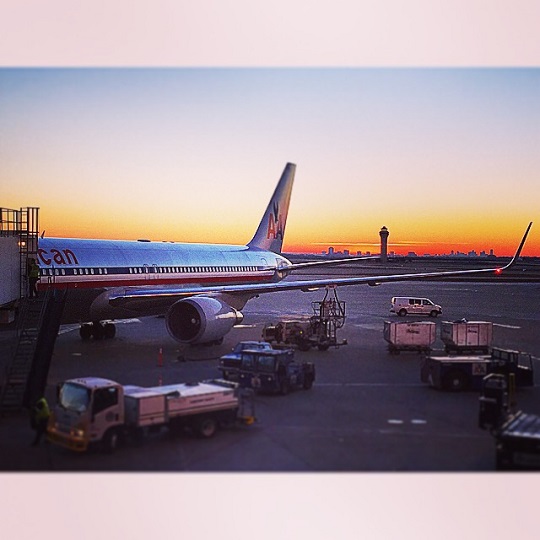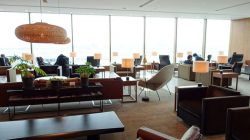
Delta Air Lines will discontinue its Seattle to Tokyo Haneda route this fall following a narrow victory over American Airlines and Hawaiian Airlines from the US DOT to retain rights to operate into Haneda, with specific requirements. Rocky provides excellent coverage of the topic in his post today on the memo Delta provided to the public in explanation for its decision to cede the route to American.
As a corollary, American Airlines will immediately have permission to fly from Los Angeles to Tokyo Haneda once Delta discontinues Seattle – Haneda, effective October 1. Presumably, American will discontinue its current daily Los Angeles – Tokyo Narita route and instead operate a daily flight into Tokyo Haneda. Although American stated previously that it would send a 777-200ER to Haneda, which it currently operates between Los Angeles and Narita, the carrier has received six Boeing 787-800s since April 2015 with an additional six scheduled for delivery in 2015, thereby serving as a possible contender for the Haneda route as well.
Delta cites competitive disadvantages as reasons for the failure of SEAHND
In its memo, Delta argued that the competitive landscape against United and American’s joint ventures with ANA and JAL, respectively, along with its lack of a local partner in Japan, were primary causes for the route to fail from Seattle. Delta has attempted various combinations and permutations to operate transpacific flights from its U.S. hubs to Tokyo Haneda, including from Detroit (shifted to Seattle) and Los Angeles to Tokyo Haneda, which Delta intends to keep to maintain a presence at Haneda.
Against the backdrop of the movements in Seattle, Delta continues to add domestic routes to beef up its Seattle gateway hub to Asia-Pacific, but also has made some additions at Los Angeles with an announcement earlier this year to operate a nonstop flight to Shanghai. Meanwhile, American announced last week that it will launch a daily 777-300ER flight between Los Angeles and Sydney, in direct competition with Delta’s longstanding route on the same city pairs. United also competes on these two long-haul routes from Los Angeles to Sydney and Shanghai.
In essence, the bloodbath that is emerging on the U.S. west coast across the Asian Pacific markets will be telling as Delta continues to contend with the weak Japanese Yen at its Tokyo hub and United lacks a local partner in Oceania (besides a relatively distant partnership with Air New Zealand). This effectively places American in a stronger position against the other two “big three” carriers in the transpacific market thanks to its joint ventures with Japan Airlines and Qantas (announced last week as part of the new service to Sydney from LAX).
American will make much better use of the Haneda slot than Delta
In its website, “Let American fly Haneda,” American touted its title as the largest carrier at LAX (although highly fragmented among several carriers to begin with) providing customers more than double the number of weekly flights and North American destinations (1,200 flights to 52 markets) over Delta at Seattle (500 weekly flights to 27 North American markets) thereby rendering it the stronger alternative.
Truth be told, Los Angeles is a much larger local market to Japan over Seattle, and in its application to the US DOT, American proposed an evening departure and late evening arrival from Los Angeles to Haneda in the summer, and a midnight departure and early evening arrival on the return leg. During the winter months, AA proposed a late afternoon departure and late afternoon return from and to LAX, with the arrival and departure times remaining the same at Haneda. American argues that these times are compliant with Haneda’s curfew rules, permitting U.S. – Haneda operations between 22:00 and 07:00 AM, with no U.S.-bound returns permitted before midnight from Haneda.
In the intermediary, American will likely deploy its 3-class configured 777s on the LAX-HND route, before eventually converting it to a 2-class cabin (high J and high Y) as they are retrofitted. It is unclear whether American will be entitled to adjust the terms of their initial application to operate a 787 on the LAX-HND route, but if possible, it may be a conservative choice. American will compete against Delta’s daily 767-300ER service to Haneda as well as ANA’s daily 777-300ER on the same route. A late arrival into Haneda, however, permits few connections onward from Haneda to limited markets on partner Japan Airlines, as mentioned by Rocky, with an early morning red-eye offered to Singapore and Bangkok.
American’s current schedule from LAX to Narita follows a noon departure from Los Angeles and a mid-afternoon arrival into Narita, and an early evening departure from Narita and a late morning return to LAX on the same day. This will obviously be no longer an option for OneWorld travelers as American will need to switch to later departure times from LAX to comply with curfew rules at Haneda.
However, joint-venture partner Japan Airlines will still operate a daily flight from LAX to Narita using approximately the same departure and arrival times from both stations as American currently uses, thereby facilitating connections onward to Asia from Narita and North America from LAX. Although the movement from Narita to Haneda is indeed a loss in terms of scheduling options, there could be hope that American will work with the DOT and Japanese government to lift the restrictions on Haneda curfew times to enable more favorable schedules for US airlines.
Other impacts on Alaska – American partnership? And DFW to Haneda?
There are other indirect benefits from the addition of Los Angeles to Haneda’s U.S. network, and that involves American’s growing codeshare with Alaska Airlines, inversely related to Delta’s unraveling relationship with Alaska out of its Seattle hub. Although Alaska has a much smaller hub at LAX relative to Seattle, the loosening ties between Delta and Alaska has a strong impact on Delta’s Seattle hub, especially if the relationship between American and Alaska helps AA at its Los Angeles hub. This, again, is compounded even further when evaluating the net contributions that AA’s long-haul growth to Haneda and Sydney will bring since Delta operates those exact same routes from LAX.
In other words, American’s return to Haneda from LAX will place intense pressure and scrutiny on Delta’s existing LAX-HND service, which, if Delta’s own words are true, is suffering from the lack of a local partner. Delta has made its own bed, now needs to sleep in it.
Separately, DFW airport announced late on Thursday via Twitter that an international route announcement was pending early morning on Friday, June 19 at 9AM CST, using the following statement:
“We’ve added 29 new international routes since 2011 and we’re not done yet. Join us 9 AM 6/19 at #AskDFWExec for more.”
One possible option could be that American will similarly relinquish one of its two DFW-Tokyo Narita flights in favor of a Japan Airlines flight to Haneda, helping to capture onward connections out of Haneda. It is mere speculation for now, but tune in tomorrow to discover more.




